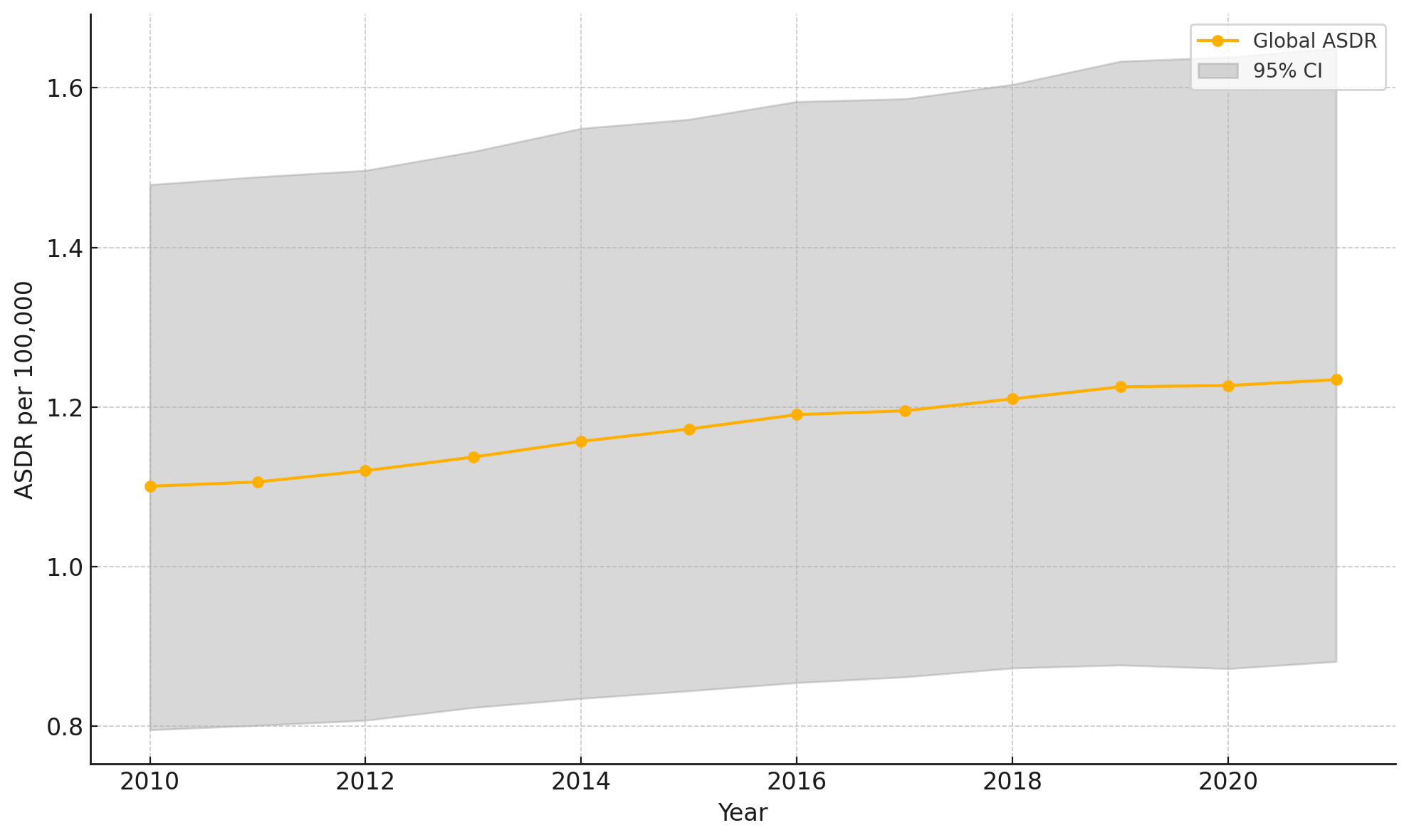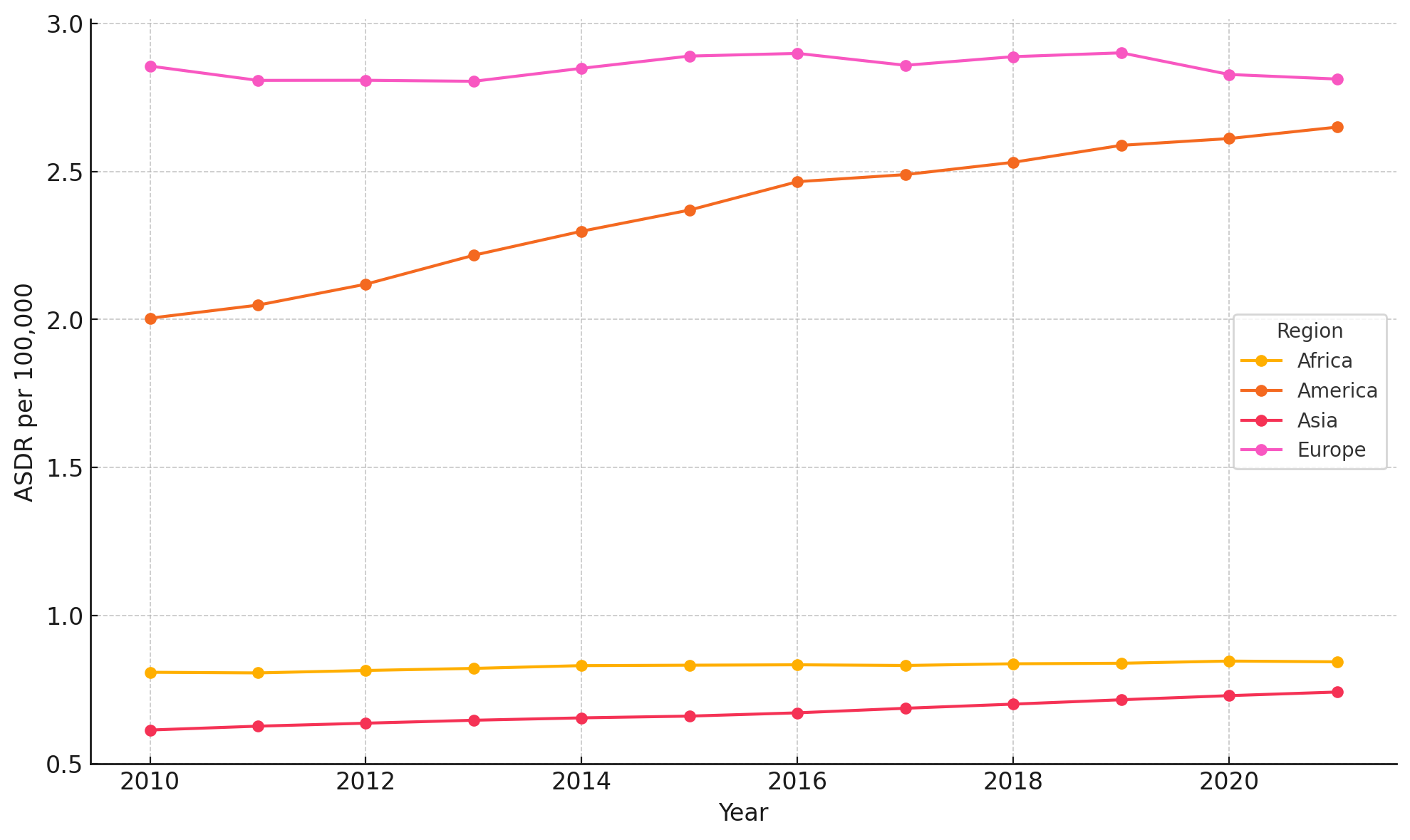Monday Poster Session
Category: Liver
P3685 - Global Trends in MASLD-Related Cirrhosis Mortality: A Rising Pandemic
Monday, October 27, 2025
10:30 AM - 4:00 PM PDT
Location: Exhibit Hall

Richeal Asante, MD
Geisinger Wyoming Valley Medical Center
Kingston, PA
Presenting Author(s)
John K. Appiah, MD1, Richeal Asante, MD2, George S. Blewusi, MD3, Nikita Garg, MD1, Edward A. Danso, MD4
1Geisinger Wyoming Valley Medical Center, Wilkes-Barre, PA; 2Geisinger Wyoming Valley Medical Center, Kingston, PA; 3Johns Hopkins Bloomberg School of Public Health, Baltimore, MD; 4Korle-Bu Teaching Hospital, Accra, Greater Accra, Ghana
Introduction: Metabolic dysfunction-associated steatotic liver disease (MASLD), previously termed nonalcoholic fatty liver disease (NAFLD), represents a growing global health concern. However, comprehensive data on worldwide mortality trends from MASLD-related cirrhosis remains limited. We analyzed global and regional trends in cirrhosis deaths attributable to MASLD using Global Burden of Disease (GBD) data.
Methods: We analyzed GBD 2010–2021 estimates for cirrhosis deaths attributable to MASLD across major world regions. Age-standardized death rates (ASDRs) per 100,000 population were extracted by year and region. We calculated global trends from 2010 to 2021 and identified regions with the highest MASLD cirrhosis mortality in 2021. Regional trends were assessed using percentage change calculations over the 12-year study period.
Results: Global MASLD cirrhosis ASDR increased significantly from 1.10 per 100,000 (95% CI: 0.80-1.48) in 2010 to 1.23 per 100,000 (95% CI: 0.88-1.65) in 2021, representing a 12.1% increase over the study period. In 2021, Europe demonstrated the highest MASLD cirrhosis ASDR at 2.81 per 100,000 (95% CI: 2.04-3.68), followed by America at 2.65 per 100,000 (95% CI: 1.91-3.50). Africa and Asia showed substantially lower rates at 0.84 and 0.74 per 100,000, respectively. Regional trends varied markedly: America experienced the largest relative increase (+32.2% from 2010-2021), followed by Asia (+20.9%) and Africa (+4.4%), while Europe showed stabilization with a slight decline (-1.5%). Europe and America demonstrated mortality rates 3-4 times higher than developing regions.
Discussion: MASLD cirrhosis mortality continues to rise globally, with particularly concerning trends in developed regions. America's 32% increase suggests an emerging epidemic, while Europe shows signs of stabilization at elevated levels. The substantial regional disparities likely reflect differences in obesity prevalence, metabolic syndrome burden, and healthcare infrastructure. These findings underscore the urgent need for targeted prevention strategies and early intervention programs, particularly in regions experiencing rapid increases in MASLD-related mortality.

Figure: Figure 1. Global MASLD cirrhosis age-standardized death rates increased 12.1% from 1.10 to 1.23 per 100,000 population (2010-2021). shaded area indicates the 95% confidence intervals. Data from Global Burden of Disease Study 2021.

Figure: Figure 2. Trends in MASLD cirrhosis ASDRs by region, 2010–2021. America and Asia showed consistent increases, Africa remained stable, and Europe slightly declined. Europe and America maintained the highest mortality rates throughout the period.
Disclosures:
John Appiah indicated no relevant financial relationships.
Richeal Asante indicated no relevant financial relationships.
George Blewusi indicated no relevant financial relationships.
Nikita Garg indicated no relevant financial relationships.
Edward Danso indicated no relevant financial relationships.
John K. Appiah, MD1, Richeal Asante, MD2, George S. Blewusi, MD3, Nikita Garg, MD1, Edward A. Danso, MD4. P3685 - Global Trends in MASLD-Related Cirrhosis Mortality: A Rising Pandemic, ACG 2025 Annual Scientific Meeting Abstracts. Phoenix, AZ: American College of Gastroenterology.
1Geisinger Wyoming Valley Medical Center, Wilkes-Barre, PA; 2Geisinger Wyoming Valley Medical Center, Kingston, PA; 3Johns Hopkins Bloomberg School of Public Health, Baltimore, MD; 4Korle-Bu Teaching Hospital, Accra, Greater Accra, Ghana
Introduction: Metabolic dysfunction-associated steatotic liver disease (MASLD), previously termed nonalcoholic fatty liver disease (NAFLD), represents a growing global health concern. However, comprehensive data on worldwide mortality trends from MASLD-related cirrhosis remains limited. We analyzed global and regional trends in cirrhosis deaths attributable to MASLD using Global Burden of Disease (GBD) data.
Methods: We analyzed GBD 2010–2021 estimates for cirrhosis deaths attributable to MASLD across major world regions. Age-standardized death rates (ASDRs) per 100,000 population were extracted by year and region. We calculated global trends from 2010 to 2021 and identified regions with the highest MASLD cirrhosis mortality in 2021. Regional trends were assessed using percentage change calculations over the 12-year study period.
Results: Global MASLD cirrhosis ASDR increased significantly from 1.10 per 100,000 (95% CI: 0.80-1.48) in 2010 to 1.23 per 100,000 (95% CI: 0.88-1.65) in 2021, representing a 12.1% increase over the study period. In 2021, Europe demonstrated the highest MASLD cirrhosis ASDR at 2.81 per 100,000 (95% CI: 2.04-3.68), followed by America at 2.65 per 100,000 (95% CI: 1.91-3.50). Africa and Asia showed substantially lower rates at 0.84 and 0.74 per 100,000, respectively. Regional trends varied markedly: America experienced the largest relative increase (+32.2% from 2010-2021), followed by Asia (+20.9%) and Africa (+4.4%), while Europe showed stabilization with a slight decline (-1.5%). Europe and America demonstrated mortality rates 3-4 times higher than developing regions.
Discussion: MASLD cirrhosis mortality continues to rise globally, with particularly concerning trends in developed regions. America's 32% increase suggests an emerging epidemic, while Europe shows signs of stabilization at elevated levels. The substantial regional disparities likely reflect differences in obesity prevalence, metabolic syndrome burden, and healthcare infrastructure. These findings underscore the urgent need for targeted prevention strategies and early intervention programs, particularly in regions experiencing rapid increases in MASLD-related mortality.

Figure: Figure 1. Global MASLD cirrhosis age-standardized death rates increased 12.1% from 1.10 to 1.23 per 100,000 population (2010-2021). shaded area indicates the 95% confidence intervals. Data from Global Burden of Disease Study 2021.

Figure: Figure 2. Trends in MASLD cirrhosis ASDRs by region, 2010–2021. America and Asia showed consistent increases, Africa remained stable, and Europe slightly declined. Europe and America maintained the highest mortality rates throughout the period.
Disclosures:
John Appiah indicated no relevant financial relationships.
Richeal Asante indicated no relevant financial relationships.
George Blewusi indicated no relevant financial relationships.
Nikita Garg indicated no relevant financial relationships.
Edward Danso indicated no relevant financial relationships.
John K. Appiah, MD1, Richeal Asante, MD2, George S. Blewusi, MD3, Nikita Garg, MD1, Edward A. Danso, MD4. P3685 - Global Trends in MASLD-Related Cirrhosis Mortality: A Rising Pandemic, ACG 2025 Annual Scientific Meeting Abstracts. Phoenix, AZ: American College of Gastroenterology.
